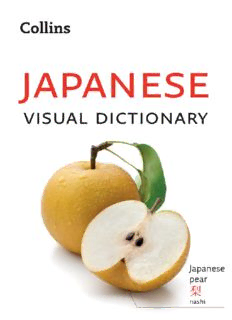
Collins Japanese Visual Dictionary PDF
Preview Collins Japanese Visual Dictionary
COPYRIGHT Published by Collins An imprint of HarperCollins Publishers Westerhill Road Bishopbriggs Glasgow G64 2QT First Edition 2019 © HarperCollins Publishers 2019 Collins® is a registered trademark of HarperCollins Publishers Limited Ebook Edition © March 2019 ISBN: 9780008319939 Version: 2019-03-28 All rights reserved under International and Pan-American Copyright Conventions. By payment of the required fees, you have been granted the non- exclusive, non-transferable right to access and read the text of this ebook on screen. No part of this text may be reproduced, transmitted, downloaded, decompiled, reverse engineered, or stored in or introduced into any information storage and retrieval system, in any form or by any means, whether electronic or mechanical, now known or hereafter invented, without the express written permission of HarperCollins. Entered words that we have reason to believe constitute trademarks have been designated as such. However, neither the presence nor absence of such designation should be regarded as affecting the legal status of any trademark. HarperCollins does not warrant that any website mentioned in this title will be provided uninterrupted, than any website will be error free, that defects will be corrected, or that the website or the server that makes it available are free of viruses or bugs. For full terms and conditions please refer to the site terms provided on the website. If you would like to comment on any aspect of this book, please contact us at the given address or online. E-mail [email protected] www.facebook.com/collinsdictionary @collinsdict CONTENTS COVER TITLE PAGE COPYRIGHT INTRODUCTION THE ESSENTIALS TRANSPORT IN THE HOME AT THE SHOPS DAY-TO-DAY LEISURE SPORT HEALTH PLANET EARTH CELEBRATIONS AND FESTIVALS ACKNOWLEDGEMENTS PHOTO CREDITS ABOUT THE PUBLISHER INTRODUCTION Whether you’re on holiday or staying in Japan for a slightly longer period of time, your Collins Visual Dictionary is designed to help you find exactly what you need, when you need it. With over a thousand clear and helpful images, you can quickly locate the vocabulary you are looking for. The Visual Dictionary includes: 10 chapters arranged thematically, so that you can easily find what you need to suit the situation images – illustrating essential items YOU MIGHT SAY… – common phrases that you might want to use YOU MIGHT HEAR… – common phrases that you might come across VOCABULARY – common words that you might need YOU SHOULD KNOW… – tips about local customs or etiquette USING YOUR COLLINS VISUAL DICTIONARY The points below explain a few basic concepts of Japanese pronunciation and grammar and will help ensure that your Collins Visual Dictionary gives you as much help as possible when using Japanese: 1) There are several systems for writing Japanese in Roman characters, but the most understandable for English speakers is called the Hepburn system, which has been adapted slightly for use in this dictionary. Long vowels (pronounced with twice the length of normal vowels) have been written with a bar over the top, except for the double i: ā ii ē ō ū bus stop バス停 basu-tē street 通り tōri 2) Japanese grammar is simple in many ways compared to European languages: there is no gender and there are no definite or indefinite articles; there is no difference between singular and plural; and verbs only have past and non-past (present or future) forms and do not change according to who is performing an action. 3) There are different levels of politeness in Japanese, but polite forms suitable for general use have been used in the phrases in this book. Verbs are shown in the “plain” form. This is the form used among family members and close friends, and to form more complex structures, so you may hear people using it. However, it is safest to stick to using the polite form to avoid appearing over-familiar or rude. In the polite form, Japanese verbs end in “-masu”. Negative forms and past tenses are made by changing the verb ending. 4) Japanese uses small words called particles to show how different parts of the sentence relate to each other. Some are similar to English prepositions, but in Japanese they come immediately after the nouns they refer to. These particles have the following functions: wa topic marker ga subject marker o direct object marker ni indirect object marker, goal and location marker to connects nouns, ‘and’ or ‘with’ de indicates by which means an action is carried out or where an action takes place no indicates that the second noun is described in some way by the first, e.g. possession mo “also/as well” kara “from/since” made “until/as far as” Other particles occur at the end of sentences to change the meaning from a straightforward statement. The most common ones are: ka question marker ne asks for agreement or confirmation yo adds emphasis Finally, some particles are used to link clauses to make more complex sentences. Two of the most useful are kara “because/so” (which always comes after the reason or cause) and ga “but/although”. 5) Japanese word order is subject – object – verb, with the verb at the end of the sentence. The basic Japanese sentence has a topic and a comment section. The topic, indicated by the topic marker wa, usually comes at the beginning of the sentence, but if it is
Description: